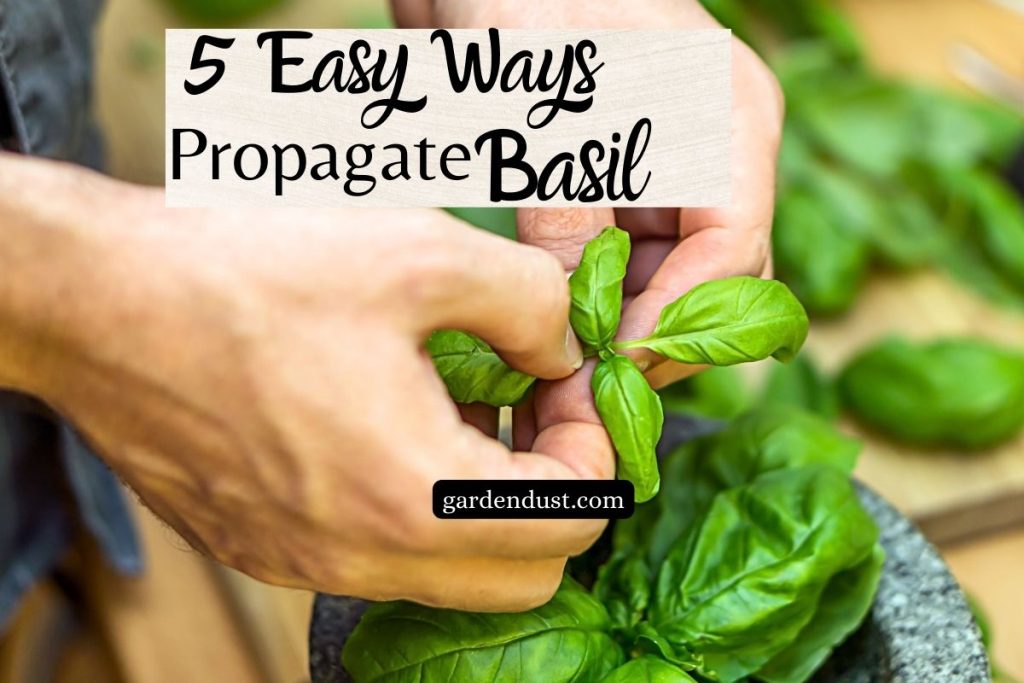Basil, with its aromatic leaves and rich flavor, is a favorite herb among gardeners and culinary enthusiasts alike. Instead of purchasing new basil plants every season, why not propagate your own? Propagation is an economical and satisfying way to expand your basil collection. In this article, we will explore how to propagate basil – 5 easy ways. Whether you’re a seasoned gardener or a novice with a green thumb, these techniques will help you grow a bountiful basil harvest right in your backyard or kitchen. Let’s start…
How To Propagate Basil – 5 Easy Ways
1. Propagation from Seeds
One of the most traditional ways to propagate basil is by starting from seeds. Begin by selecting high-quality basil seeds from a reputable source or save seeds from your existing basil plants. To start, fill a seed tray or small pots with a well-draining seed-starting mix. Sow the basil seeds on the surface and lightly press them into the soil. Mist the soil with water to keep it consistently moist.
Place the tray or pots in a warm, sunny location, as basil seeds require warmth and sunlight for germination. Once the seedlings have grown large enough to handle, transplant them into individual pots or directly into the garden. This method allows you to control the entire growth process, from seed to mature plant.
2. Cuttings in Water
Another popular method for propagating basil is through stem cuttings in water. Select healthy, non-flowering stems from your existing basil plant, cutting them just below a leaf node. Remove any leaves from the lower portion of the cutting, leaving only a few at the top.
Place the cuttings in a jar or glass filled with water, ensuring that the nodes where the leaves were removed are submerged. Change the water every few days to keep it fresh and remove any potential for rot. After a few weeks, you will notice roots developing. Once the roots are a few inches long, transplant the cuttings into soil or directly into your garden. This method is quick and visually rewarding, making it a favorite among those who enjoy watching the roots grow.
READ ALSO:-How To Grow And Care For Chamomile Plant
3. Propagation in Soil
Propagating basil in soil is another reliable method. Take cuttings as previously described, but this time, dip the cut end in rooting hormone to encourage root development. Plant the cuttings in a well-draining potting mix, burying them deep enough to cover the nodes where the leaves were removed.
Water the cuttings gently and cover them with a plastic bag or a plastic dome to create a humid environment. This will support the formation of roots. Place the container in a warm, bright location but avoid direct sunlight to prevent the cuttings from drying out. Once the roots are well-established, transplant the basil into larger pots or your garden.
4. Division
Division is a straightforward method that involves separating an established basil plant into multiple plants. Choose a mature basil plant with several stems and gently dig it out of the ground. Shake off excess soil to expose the root system.
Using a sharp knife or your hands, divide the plant into smaller sections, ensuring each division has both roots and stems. Replant the divisions in their desired locations, whether it be in pots or directly in the garden. Water the newly divided plants thoroughly to help them establish in their new environment. This method is particularly useful for rejuvenating older basil plants and creating multiple plants from a single source.
5. Propagation from Root Cuttings
Root cuttings are a lesser-known but effective way to propagate basil. Begin by digging up a mature basil plant, and cut a healthy, thick root section from the main root ball. The root cutting should be around 4-6 inches long.
Plant the root cutting in a pot filled with well-draining soil, burying it at least 2 inches deep. Water the cutting well and place the pot in a warm and sunny location. Keep the soil consistently moist but not waterlogged. After a few weeks, new shoots will emerge from the soil, indicating successful root development.
Once the new shoots are a few inches tall, transplant the rooted cutting into a larger pot or directly into your garden. This method is an excellent way to propagate basil when the main plant has become overgrown or if you want to create new plants from the root system.
With these five easy and detailed methods for propagating basil, you can enjoy a continuous supply of this flavorful herb in your garden or kitchen. Whether you prefer starting from seeds, cuttings in water, soil propagation, division, or root cuttings, each technique offers its own unique advantages. Experiment with different methods to find the one that suits your preferences and gardening style. With a bit of patience and care, you’ll be harvesting fresh basil leaves in no time, enhancing your culinary creations with the delightful taste and aroma of homegrown herbs. Happy Gardening….







